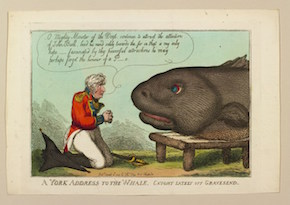 Les estampes, dessins et aquarelles de Thomas Rowlandson (1756-1827), présentés dans l’exposition à venir High Spirits: The Comic Art of Thomas Rowlandson à la Queen’s Gallery au Palais de Buckingham, ont longtemps été reconnus comme un mélange remarquable d’invention satirique et de virtuosité artistique. La journée d’étude, co-organisée par la Royal Collection Trust et le Centre Paul Mellon de recherches en art britannique, prend l’oeuvre de Rowlandson comme point de départ pour examiner plus largement la satire britannique — dans les dessins, la gravure, ou les oeuvres sur papier — depuis les dernières années du XVIIIe siècle jusqu’à aujourd’hui.
Les estampes, dessins et aquarelles de Thomas Rowlandson (1756-1827), présentés dans l’exposition à venir High Spirits: The Comic Art of Thomas Rowlandson à la Queen’s Gallery au Palais de Buckingham, ont longtemps été reconnus comme un mélange remarquable d’invention satirique et de virtuosité artistique. La journée d’étude, co-organisée par la Royal Collection Trust et le Centre Paul Mellon de recherches en art britannique, prend l’oeuvre de Rowlandson comme point de départ pour examiner plus largement la satire britannique — dans les dessins, la gravure, ou les oeuvres sur papier — depuis les dernières années du XVIIIe siècle jusqu’à aujourd’hui.
Rowlandson et après est inspiré par le développement récent de travaux ambitieux sur les satires picturales des périodes géorgienne et victorienne, et par le désir d’explorer l’identité de la satire graphique comme une forme fluide, hybride, qui semble être à cheval sur des mondes différents — l’art, le journalisme, la littérature et la politique — plutôt qu’appartenir à une sphère culturelle particulière. En conséquence, on sollicite des communications portant sur des exemples de satires graphiques produites dans les 250 dernières années, notamment autour des questions suivantes :
• Que peut nous apprendre l’oeuvre de Rowlandson sur le fonctionnement général de la satire graphique à son époque, et comment a-t-elle contribué à façonner la pratique de ses successeurs ?
• Quels sont les caractéristiques formelles, iconographique, technique et textuelles de ce type particulier de pratique artistique à différents moments historiques, et comment et pourquoi ont-elles changé ?
• Quelle est la relation entre la satire graphique et d’autres formes d’art visuel ?
• Quel genre d’artiste est associé à cette forme de pratique artistique, et comment la figure du satiriste a-t-elle été définie et pensée ?
• Comment l’histoire de la satire graphique a-t-elle été façonnée par l’évolution des techniques d’impression ?
• Quelle est la relation entre la satire graphique et le journalisme; la satire graphique et la littérature; ou la satire graphique et le discours politique ?
• Comment les histoires de la satire graphique sont-elles liées à l’humour britannique?
• Comment la satire graphique fonctionne-t-elle aujourd’hui, et quels sont les exemples contemporains qui pourraient être comparés à l’œuvre d’artistes tels que Rowlandson?
La journée se déroulera au Centre Paul Mellon au palais de Buckingham. Merci d’envoyer vos propositions (pas plus de 250 mots) pour des communications de 20 minutes à Ella Fleming, Events Manager, events@paul-mellon-centre.ac.uk avant le 25 septembre 2015 (avant 17h).
Rowlandson et après: Repenser la satire graphique
Centre Paul Mellon et la Queen’s Gallery, Palais de Buckingham,Londres, le 22 Janvier 2016
Une journée d’étude organisée en collaboration par la Royal Collection Trust et le Centre Paul Mellon de recherche en art britannique
****
The prints, drawings and watercolours of Thomas Rowlandson (1756–1827), which are to be showcased in the forthcoming exhibition High Spirits: The Comic Art of Thomas Rowlandson at The Queen’s Gallery, Buckingham Palace, have long been recognised as offering a remarkable combination of satirical invention and artistic brilliance.This study-day, which has been co-organised by Royal Collection Trust and The Paul Mellon Centre for Studies in British Art, uses Rowlandson’s work as the starting-point for a broader art-historical examination of British graphic satire—whether drawn, engraved or painted on paper—between the later years of the 18th century and today.
Rowlandson and After is inspired by the recent upsurge in ambitious scholarship on the pictorial satires of the Georgian and Victorian periods, and by a desire to explore graphic satire’s long-standing identity as a fluid, hybrid form that seems always to straddle different worlds—art, journalism, literature and politics—rather than belonging fully to any one particular cultural sphere. Accordingly, submissions are invited that engage with examples of graphic satire dating from any point across the last 250 years and that address the following questions, among others:
• What can Rowlandson’s work tell us about the broader workings of graphic satire in his period, and how has it helped shape the practice of his successors?
• What have been the distinctive formal, iconographic, technical and textual characteristics of this particular strand of artistic practice at different historical moments, and how and why have they changed?
• What is the relationship between graphic satire and other forms of visual art?
• What kind of artistic persona is associated with this form of practice—how has the figure of the satirist been defined and imagined?
• How has the history of graphic satire been shaped by developments in print technology?
• What is the relationship between graphic satire and journalism; or graphic satire and literature; or graphic satire and political discourse?
• How might histories of graphic satire be related to histories of British humour?
• How does graphic satire operate today—and how might contemporary examples of the genre be compared to the work of artists such as Rowlandson?
The day will be split between The Paul Mellon Centre and The Queen’s Gallery, Buckingham Palace. Please send proposals (of no more than 250 words) for 20-minute papers to Ella Fleming, Events Manager, events@paul-mellon-centre.ac.uk by 5.00pm on 25 September 2015.

Leave a Reply
You must be logged in to post a comment.